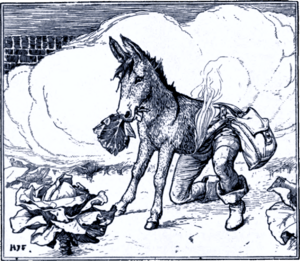Donkey Cabbages facts for kids
Quick facts for kids Donkey Cabbages |
|
|---|---|

The effects of the shapeshifting herbs: the man becomes a donkey. Illustration from The Yellow Fairy Book (1894).
|
|
| Folk tale | |
| Name | Donkey Cabbages |
| Data | |
| Aarne-Thompson grouping | ATU 567 (The Magical Bird-Heart) |
| Country | Germany |
| Published in | Kinder- und Hausmärchen by the Brothers Grimm |
| Related |
|
Donkey Cabbages (also called The Donkey Cabbage; German: Der Krautesel) is a German fairy tale. The famous Brothers Grimm collected this story. It is tale number 122 in their well-known collection.
The story is about a man who hunts birds in a forest. He gains some amazing magical objects. By eating the heart of one bird, he gets a never-ending source of gold coins. Later, three witches steal his magic and special items. But he gets them back using a special herb. This herb can turn people into donkeys!
Contents
The Magical Adventure Begins
A huntsman once helped an old woman. He gave her some money. She told him to go to a special tree. There, nine birds were fighting over a cloak. The old woman said if he shot into the group, one bird would die. The birds would then drop the cloak. This cloak was a magical wishing cloak. She also told him that if he ate the dead bird's heart, he would find a gold coin by his pillow every morning.
The huntsman followed her advice. He shot into the birds and got the wishing cloak. He also ate the bird's heart. Soon, he found a gold coin by his pillow each morning. He decided to travel and see the world.
Meeting the Witch and Her Daughter
The huntsman arrived at a castle. An old witch lived there with her beautiful daughter. The witch knew about the magical bird's heart. She told her daughter how to steal it. The daughter gave the huntsman a drink. After he drank it, the bird's heart came out. The daughter quickly swallowed it herself.
Next, the witch told her daughter to steal the wishing cloak. She explained how to do it. The daughter looked at a distant mountain called Garnet Mountain. She told the huntsman she wished she were there. He took her under the cloak. He then wished for them both to be on Garnet Mountain.
While they were there, the huntsman fell asleep. The witch's daughter then stole the wishing cloak. She wished herself back home to the castle.
A Cloud Ride and Magic Cabbages
The huntsman woke up alone on the mountain. Three giants saw him. They talked about killing him. But the third giant said a cloud would carry him away. The huntsman climbed up the mountain. A cloud appeared and carried him off.
The cloud took him to a cabbage garden. He was very hungry. He ate some of the cabbage. Suddenly, he turned into a donkey! He was surprised but kept going. He found a different patch of cabbage. He ate some of that, and it turned him back into a man.
The huntsman had an idea. He took both kinds of cabbage with him. He then went back to the castle where the witch lived.
Donkeys at the Castle
The huntsman pretended to be a royal messenger. He told the witch he was sent to get the finest cabbage for the king. He said he was worried the heat would make it wilt. The witch asked for some of the special cabbage.
He gave her the cabbage that turned people into donkeys. The witch, her maidservant, and her daughter all ate it. Just as he planned, they all became donkeys!
The huntsman then sold the three donkeys to a miller. He gave the miller special instructions. He told him to give the oldest donkey (the witch) one meal a day and three beatings. The middle donkey (the maidservant) should get three meals and one beating. The youngest donkey (the witch's daughter) should get three meals and no beatings.
The Return and a Happy Ending
After some time, the huntsman returned to the miller. He wanted to see how the donkeys were doing. The miller told him that the oldest donkey had died. He also said the two younger donkeys were very sad. He thought they might die too.
The huntsman bought the two remaining donkeys back. He then used the other magical cabbage to turn them back into women. The witch's daughter told him where the wishing cloak was hidden. She also offered to give him back the bird's heart, since it had been stolen. But the huntsman said it didn't matter. He said if they married, it would make no difference. So, they were married soon after.
Other Versions of the Story
The Brothers Grimm had an earlier version of this tale. It was called Die lange Nase (The Long Nose). It had many similar parts to "Donkey Cabbages."
The famous writer Andrew Lang included this story in his book, The Yellow Fairy Book.
The tale was also translated as The Salad. It was published in Grimm's Goblins: Grimm's Household Stories by Edgar Taylor.
Ruth Manning-Sanders included a version called "The Donkey Lettuce." This was in her book, A Book of Witches.

